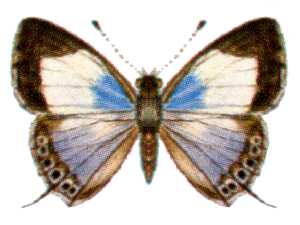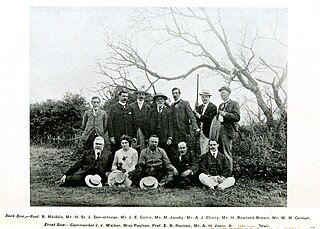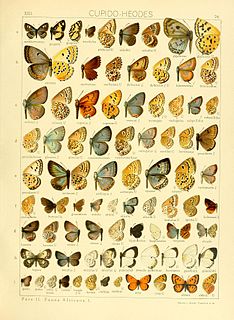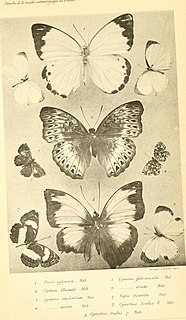
The superfamily Papilionoidea contains all the butterflies except for the moth-like Hedyloidea.

Lycaenidae is the second-largest family of butterflies, with over 6,000 species worldwide, whose members are also called gossamer-winged butterflies. They constitute about 30% of the known butterfly species.

Riodinidae is the family of metalmark butterflies. The common name "metalmarks" refers to the small, metallic-looking spots commonly found on their wings. The 1532 species are placed in 146 genera. Although mostly Neotropical in distribution, the family is also represented both in the Nearctic and the Palearctic.

The chalkhill blue is a butterfly in the family Lycaenidae. It is a small butterfly that can be found throughout the Palearctic realm, where it occurs primarily in grasslands rich in chalk. Males have a pale blue colour, while females are dark brown. Both have chequered fringes around their wings.

Brigadier William Harry Evans CSI CIE DSO was a lepidopterist and British Army officer who served in India. He documented the butterfly fauna of India, Burma and Ceylon in a series of articles in the Journal of the Bombay Natural History Society. Brigadier Evans was especially interested in the taxonomy and systematics of the butterfly families Lycaenidae and Hesperiidae an example being his A revision of the Arhopala group of Oriental Lycaenidae Bull. British Mus. , Ent., vol. 5: pp. 85–141 (1957).

Miletinae is a subfamily of the family Lycaenidae of butterflies, commonly called harvesters and woolly legs, and virtually unique among butterflies in having predatory larvae. Miletinae are entirely aphytophagous. The ecology of the Miletinae is little understood, but adults and larvae live in association with ants, and most known species feed on Hemiptera, though some, like Liphyra, feed on the ants themselves. The butterflies, ants, and hemipterans, in some cases, seem to have complex symbiotic relationships benefiting all.
George Thomas Bethune-Baker was an English entomologist who specialised in Lepidoptera, especially those in the family Lycaenidae of butterflies.

Zizeeria knysna, the dark grass blue or African grass blue, is a species of blue butterfly (Lycaenidae) found in Africa, on Cyprus and the Iberian Peninsula.

Oboronia is an Afrotropical genus of butterfly in the family Lycaenidae.
Lachnocnema durbani, the D'Urban's woolly legs, is a butterfly of the family Lycaenidae. It is found from Cape Point and KwaZulu-Natal to Mozambique to Kenya, Malawi, Tanzania, and Uganda. The habitat consists of grassy areas in savanna.

Callophrys sheridanii, the Sheridan's hairstreak and Sheridan's green hairstreak, is a butterfly in the family Lycaenidae. It is found in North America along the south coast of British Columbia and parts of Nevada, Arizona, Saskatchewan, North Dakota, and New Mexico. In 2009, this species was adopted as the U.S. state butterfly for Wyoming.

Jameela is a genus of butterflies in the family Lycaenidae.

Hamilton Herbert Charles James Druce was an English entomologist who specialised in Lycaenidae and to a lesser extent Hesperiidae. He is not to be confused with his father, the English entomologist Herbert Druce (1846–1913) who also worked on Lepidoptera.
Oboronia albicosta is a butterfly in the family Lycaenidae. It is found in Cameroon, the Democratic Republic of the Congo, Uganda and Zambia.

Oboronia guessfeldti, the Güssfeldt's blue or Güssfeldt's ginger white, is a butterfly in the family Lycaenidae. It is found in Senegal, Guinea-Bissau, Guinea, Sierra Leone, Liberia, Ivory Coast, Ghana, Togo, Nigeria, Cameroon, the Republic of the Congo, the Central African Republic, Angola, the Democratic Republic of the Congo, Uganda, western Kenya and northern Zambia. The habitat consists of drier forests, Guinea savanna and rarely also wet forests.
Oboronia liberiana, the Liberian ginger white, is a butterfly in the family Lycaenidae. It is found in Liberia, Ivory Coast and Ghana. The habitat consists of wetter forests.

Oboronia ornata, the untailed ginger white, is a butterfly in the family Lycaenidae. It is found in Guinea, Sierra Leone, Liberia, Ivory Coast, Ghana, Togo, Nigeria, Cameroon, Equatorial Guinea, Gabon, the Republic of the Congo, the Democratic Republic of the Congo, Uganda and Tanzania. The habitat consists of forests and Guinea savanna in riparian vegetation.
Oboronia pseudopunctatus, the light ginger white, is a butterfly in the family Lycaenidae. It is found in Ghana, Togo, Nigeria, Cameroon, Bioko, Gabon, the Republic of the Congo, Angola, the Democratic Republic of the Congo, Uganda and north-western Tanzania. The habitat consists of forests.

Oboronia punctatus, the common ginger white, is a butterfly in the family Lycaenidae. It is found in Guinea, Liberia, Ivory Coast, Ghana, Togo, Nigeria, Cameroon, the Republic of the Congo, Angola, the Central African Republic, the Democratic Republic of the Congo, western Uganda and north-western Tanzania. The habitat consists of forests.












